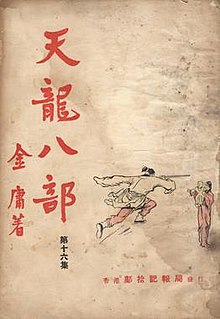 Volume 16 of an early edition of Demi-Gods and Semi-Devils | |
| Author | Jin Yong |
|---|---|
| Original title | 天龍八部 |
| Language | Chinese |
| Genre | Wuxia |
| Publisher | Ming Pao, Nanyang Siang Pau |
Publication date | 3 September 1963 |
| Publication place | Hong Kong |
| Media type | |
| Preceded by | The Sword of the Yue Maiden |
| Followed by | The Legend of the Condor Heroes |
| Demi-Gods and Semi-Devils | |||||||||||
|---|---|---|---|---|---|---|---|---|---|---|---|
| Traditional Chinese | 天龍八部 | ||||||||||
| Simplified Chinese | 天龙八部 | ||||||||||
| Literal meaning | The Deva, the Nāga, the Eight Sections | ||||||||||
| |||||||||||
Demi-Gods and Semi-Devils is a wuxia novel by Jin Yong (Louis Cha). It was first serialised concurrently from 3 September 1963 to 27 May 1966 in the newspapers Ming Pao in Hong Kong[1] and Nanyang Siang Pau in Singapore. It has been adapted into films and television series in Hong Kong, Taiwan and Mainland China numerous times since the 1970s. Set in 11th-century China, the plot is made up of separate yet intertwining storylines revolving around three protagonists – Qiao Feng, Duan Yu and Xuzhu – and other characters from various empires (Song, Liao, Dali, Western Xia and Tibet) and martial arts sects. The novel examines the cause and effect that form and break the inherent bonds underlying each major character's struggles on five uniquely corresponding levels: self, family, society, ethnic group, and country (dominion).
The novel's Chinese title is a reference to the eight races of demi-gods and semi-devils described in Buddhist cosmology as the major characters are based on the eight races. In Buddhism, these demi-gods and semi-devils are markedly different from the human race but are still bound to Saṃsāra by their own desires. Jin Yong originally modelled each major character after one of the races but, as he continued writing, the complexity of the story made it impossible for such a simplistic mapping.[2] The novel's title has been a challenge for translators for years before it was decided to be Demi-Gods and Semi-Devils. An alternative English title is Eight Books of the Heavenly Dragon.[3]
- ^ The date conforms to the data published in Chen Zhenhui (陳鎮輝), Wuxia Xiaoshuo Xiaoyao Tan (武俠小說逍遙談), 2000, Huizhi Publishing Company (匯智出版有限公司), p. 58.
- ^ Preface of the novel
- ^ Dingbo, Wu; Murphy, Patrick D., eds. (1994). "Gallant Fiction". Handbook of Chinese Popular Culture. Greenwood Press. p. 248. ISBN 0313278083.